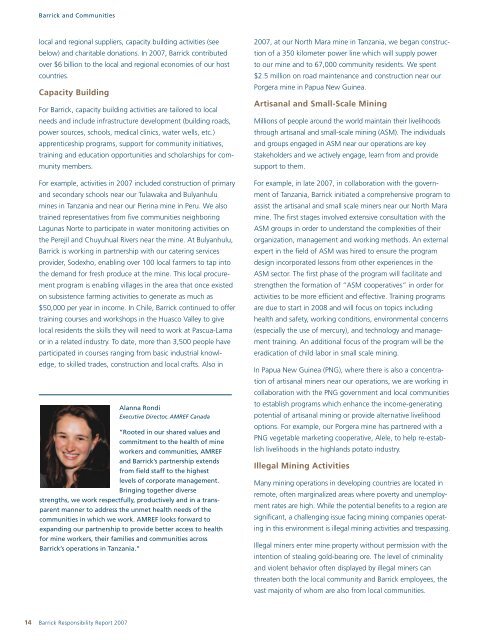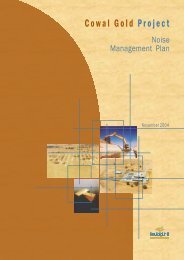2007 Responsibility Report - English (PDF) - Barrick Gold Corporation
2007 Responsibility Report - English (PDF) - Barrick Gold Corporation
2007 Responsibility Report - English (PDF) - Barrick Gold Corporation
- No tags were found...
You also want an ePaper? Increase the reach of your titles
YUMPU automatically turns print PDFs into web optimized ePapers that Google loves.
<strong>Barrick</strong> and Communitieslocal and regional suppliers, capacity building activities (seebelow) and charitable donations. In <strong>2007</strong>, <strong>Barrick</strong> contributedover $6 billion to the local and regional economies of our hostcountries.Capacity BuildingFor <strong>Barrick</strong>, capacity building activities are tailored to localneeds and include infrastructure development (building roads,power sources, schools, medical clinics, water wells, etc.)apprenticeship programs, support for community initiatives,training and education opportunities and scholarships for communitymembers.For example, activities in <strong>2007</strong> included construction of primaryand secondary schools near our Tulawaka and Bulyanhulumines in Tanzania and near our Pierina mine in Peru. We alsotrained representatives from five communities neighboringLagunas Norte to participate in water monitoring activities onthe Perejil and Chuyuhual Rivers near the mine. At Bulyanhulu,<strong>Barrick</strong> is working in partnership with our catering servicesprovider, Sodexho, enabling over 100 local farmers to tap intothe demand for fresh produce at the mine. This local procurementprogram is enabling villages in the area that once existedon subsistence farming activities to generate as much as$50,000 per year in income. In Chile, <strong>Barrick</strong> continued to offertraining courses and workshops in the Huasco Valley to givelocal residents the skills they will need to work at Pascua-Lamaor in a related industry. To date, more than 3,500 people haveparticipated in courses ranging from basic industrial knowledge,to skilled trades, construction and local crafts. Also inAlanna RondiExecutive Director, AMREF Canada”Rooted in our shared values andcommitment to the health of mineworkers and communities, AMREFand <strong>Barrick</strong>’s partnership extendsfrom field staff to the highestlevels of corporate management.Bringing together diversestrengths, we work respectfully, productively and in a transparentmanner to address the unmet health needs of thecommunities in which we work. AMREF looks forward toexpanding our partnership to provide better access to healthfor mine workers, their families and communities across<strong>Barrick</strong>’s operations in Tanzania.“<strong>2007</strong>, at our North Mara mine in Tanzania, we began constructionof a 350 kilometer power line which will supply powerto our mine and to 67,000 community residents. We spent$2.5 million on road maintenance and construction near ourPorgera mine in Papua New Guinea.Artisanal and Small-Scale MiningMillions of people around the world maintain their livelihoodsthrough artisanal and small-scale mining (ASM). The individualsand groups engaged in ASM near our operations are keystakeholders and we actively engage, learn from and providesupport to them.For example, in late <strong>2007</strong>, in collaboration with the governmentof Tanzania, <strong>Barrick</strong> initiated a comprehensive program toassist the artisanal and small scale miners near our North Maramine. The first stages involved extensive consultation with theASM groups in order to understand the complexities of theirorganization, management and working methods. An externalexpert in the field of ASM was hired to ensure the programdesign incorporated lessons from other experiences in theASM sector. The first phase of the program will facilitate andstrengthen the formation of “ASM cooperatives” in order foractivities to be more efficient and effective. Training programsare due to start in 2008 and will focus on topics includinghealth and safety, working conditions, environmental concerns(especially the use of mercury), and technology and managementtraining. An additional focus of the program will be theeradication of child labor in small scale mining.In Papua New Guinea (PNG), where there is also a concentrationof artisanal miners near our operations, we are working incollaboration with the PNG government and local communitiesto establish programs which enhance the income-generatingpotential of artisanal mining or provide alternative livelihoodoptions. For example, our Porgera mine has partnered with aPNG vegetable marketing cooperative, Alele, to help re-establishlivelihoods in the highlands potato industry.Illegal Mining ActivitiesMany mining operations in developing countries are located inremote, often marginalized areas where poverty and unemploymentrates are high. While the potential benefits to a region aresignificant, a challenging issue facing mining companies operatingin this environment is illegal mining activities and trespassing.Illegal miners enter mine property without permission with theintention of stealing gold-bearing ore. The level of criminalityand violent behavior often displayed by illegal miners canthreaten both the local community and <strong>Barrick</strong> employees, thevast majority of whom are also from local communities.14 <strong>Barrick</strong> <strong>Responsibility</strong> <strong>Report</strong> <strong>2007</strong>
















